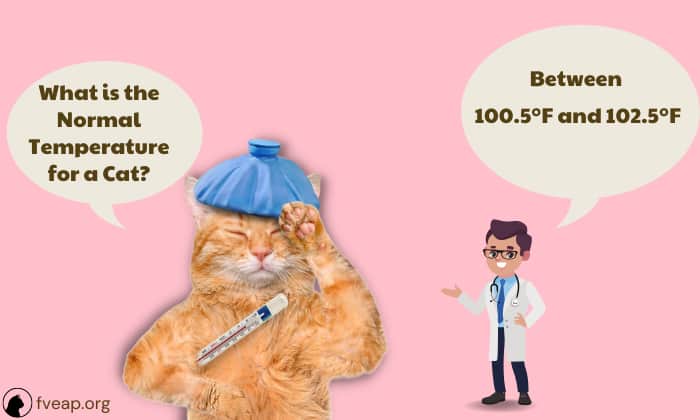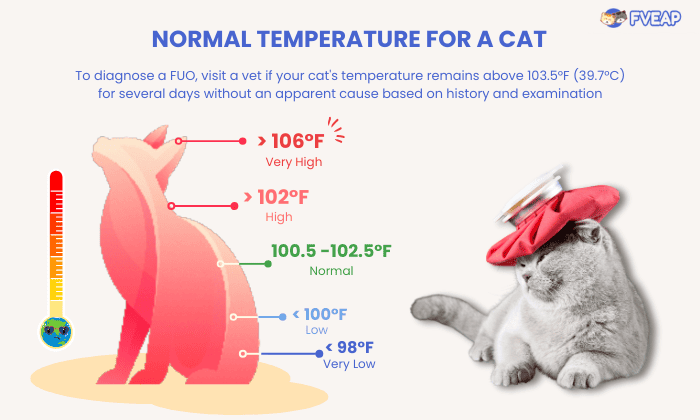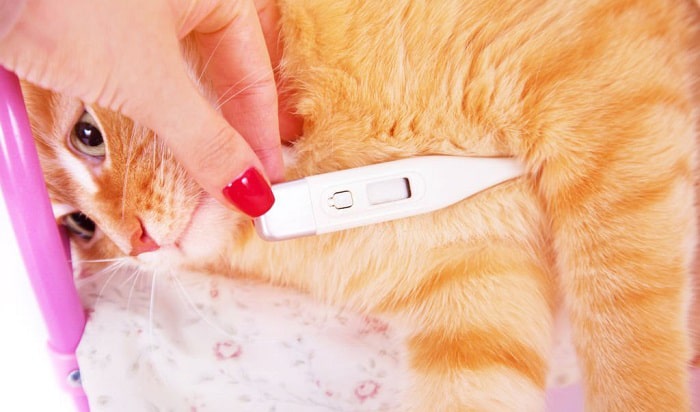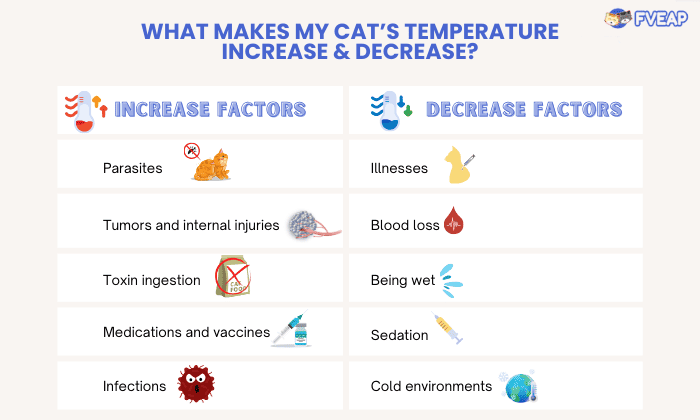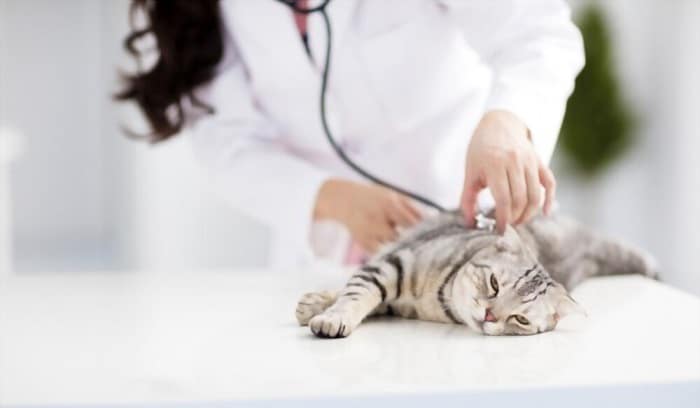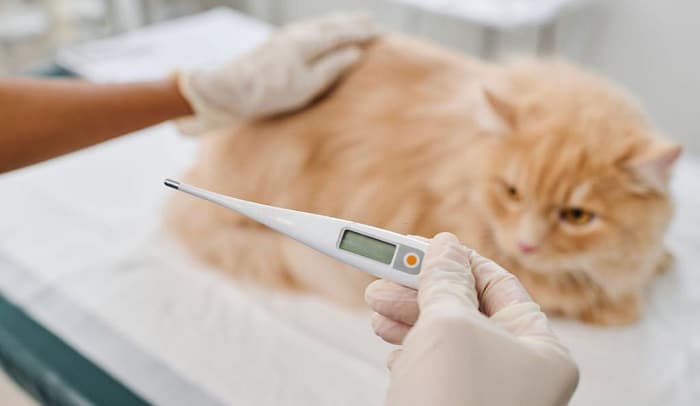Cats have the tendency to be quiet when they are feeling unwell. This makes it difficult to check if they are sick or not unless there is a physical manifestation. When they feel warm to the touch, you may wonder, “Is this all right?”
“What is the normal temperature for a cat?” Keep in mind that between 100.5°F and 102.5°F is the feline normal temperature.
However, how would you confirm if your pet does have a fever? Are there other signs to look out for? What should you do to treat your feline friend? Read on to know all the important information.
Table of Contents
Normal Vital Signs
To know whether or not your cat is sick, you must be aware of a cat’s vital signs.
Temperature – In Celsius, the ordinary temperature for cats ranges from 37.2°C to 39.2°C. On the other hand, the average temperature for kittens is between 95°F to 101°F.
Below is a guide for the ideal cat temperature for kittens:
- Neonatal or newborns (0-4 weeks) – 95-99°F
- Kitten (2-3 weeks) – 97-100°F
- Kitten (4 weeks) – 99-101°F
- Older Kitten (beyond 4 weeks) – 100.5-102.5°F
Take note that kittens are unable to regulate their temperature. They are still in the development stages and prone to illnesses. You should keep them in check from time to time.
- Heart Rate – 140 to 220 beats per minute. This may vary slightly based on the cat’s weight, age, and fitness level.
- Respiratory Rate – 24-30 breaths per minute. This also may differ depending on your pet’s age and weight.
- Mucous Membrane or Hydration Status – healthy pink and moist, especially for eyelids and gums. There should be no hints of bright red suggesting bleeding or any other color.
- Blood Pressure – 120-130 mmHg. Keep in mind that cats between four and 20 years of age are prone to high blood pressure.
What Makes My Cat’s Temperature Increase and Decrease?
Typically, a fever can cause a cats body temperature to fluctuate. Similarly, a cat temperature low is also possible.
The cause can either be from within or outside the feline’s body. This former happens to improve the immune system. Bacteria and viruses are unable to reproduce in a heated environment.
However, when a cat temperature 104°F or sometimes above 105°F, which is out of the normal cat temperature range, it is a cause of serious concern. You will notice your pet becoming lethargic, dehydrated, and refusing to eat.
Sometimes, this becomes an FUO or Fever of Unknown Origin. The common possible reasons are bacterial infection and viral infection.
The only way to confirm the FUO is a visit to the veterinarian. The professional will have your cat undergo several tests such as blood tests, urinalysis, feline leukemia virus (FeLV), and complete blood cell count (CBC).
How to Check Your Cat’s Temperature?
There are different thermometers that can be used to measure your cat’s body temperature. You can use digital thermometers for the ears or a pediatric rectal one.
The digital rectal thermometer is recommended for its more accurate reading. Unlike older versions that use mercury, digital ones read faster. It is also safer as it doesn’t contain mercury which can be dangerous for you and your cat.
Follow these steps if you are using a rectal thermometer:
- Set the thermometer to zero before you lubricate the end with petroleum jelly. An oil or even Vaseline will do.
- Position your cat such that it is neatly tucked under your arm. You can also do a cat burrito so it can feel secure within a soft blanket. Allow your cat to calm down first to avoid hurting it.
- Afterward, carefully raise the tail so you can gently insert the thermometer into its anus. For kittens, it should be inserted for no more than ¾ inches. For adult cats, at least half an inch to one inch is fine.
- Make sure the thermometer stays in the anus for at least three minutes. You may pet your cat while waiting for the time. Make it feel safe and comfortable.
- Once the device starts beeping, take it out and record the reading. Again, a cat temperature range is between 100.5°F and 102.5°F. You will find it a fever kitten if the temperature is between 95°F to 101°F.
- You can clean the thermometer with wet wipes or wash it with water and antibacterial soap.
- Store the device in a cool, dry place, away from any devices and essentials meant for human use. This is to keep things hygienic in your home.
Follow these steps if you are using an ear thermometer:
- Make your cat stand on a flat surface like a table or a couch. Keep it comfortable so it won’t try to make a fuss or get away from you.
- Set the digital thermometer to zero. Afterward, hold your cat and keep its head still. You can ask for assistance to help calm the cat.
- Gently insert the thermometer into the cat’s ear. Keep it in a horizontal position, waiting for two minutes or at least until the device beeps.
- Record the temperature before disinfecting the thermometer. Similar to rectal ones, wipe the end with a wet cloth or wash it directly with soap.
Check Cat’s Vitals
1. Heart Rate
Lay down your cat on its right side. Touch its chest and count the number of heartbeats per minute (bpm).
You can count for 15 seconds and then multiply by 4. The result should be between 140-220 beats per minute.
2. Respiratory Rate
Count the intakes for one minute. The result should be 24-30 breaths per minute. If your cat is in a relaxed state, then the breaths are on a lower scale.
If you hear wheezing or fast and labored breathing, you may wait for an hour. But if it still doesn’t stop even when your pet is relaxed, take it to the veterinarian right away.
3. Blood Pressure
You can check for blood pressure with a cuff device. Similar to the cuffs for humans, this can be wrapped around a limb or a tail. Press the button to inflate it. Allow the device to read your cat’s blood pressure before gently removing it.
Conclusion
“What is the normal temperature for a cat?” is crucial to know for all cat owners. Being familiar with its normal vital signs can help your pet stay healthy. From identifying the temperature to its heart rate, respiratory rate, and more, you can determine how to treat your cat.
Your best action is to take your feline friend to the veterinarian once a health problem is confirmed. The professional will recommend medicines and you can always shower your cat with extra care along the way.

I am Amy Sawy, a Doctor of Veterinary Medicine (DVM) graduate from the University of Kansas. y husband, Dr. Plummer, and I own a veterinary clinic in Phillipsburg, Kansas. In addition to my professional background, I am a devoted pet owner myself, with a household that includes dogs, rodents, and most notably, cats – a total of five felines in my home.
In 2020, I joined an organization as a professional writer, leveraging my experience and collaborating with my team to deliver the most valuable information for your cat’s care.


